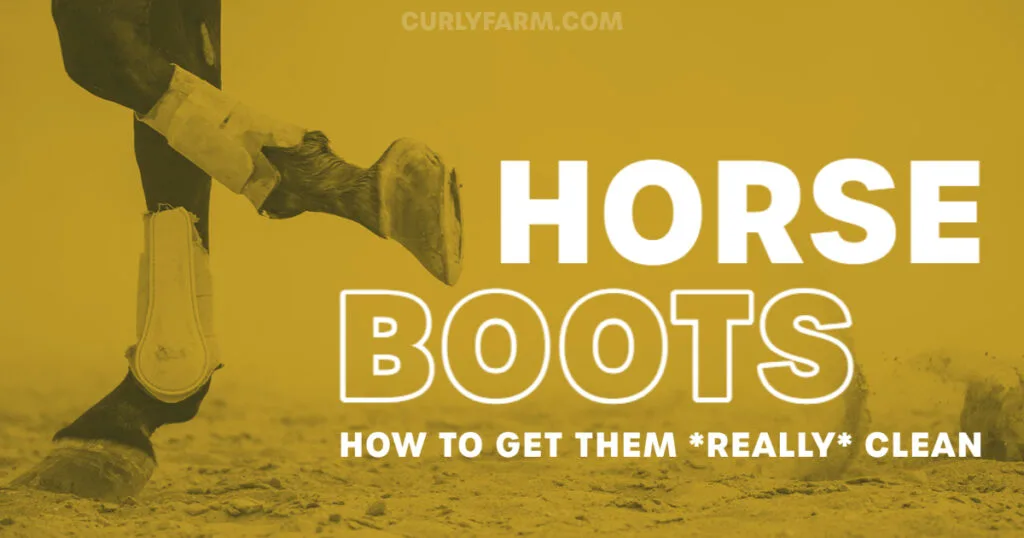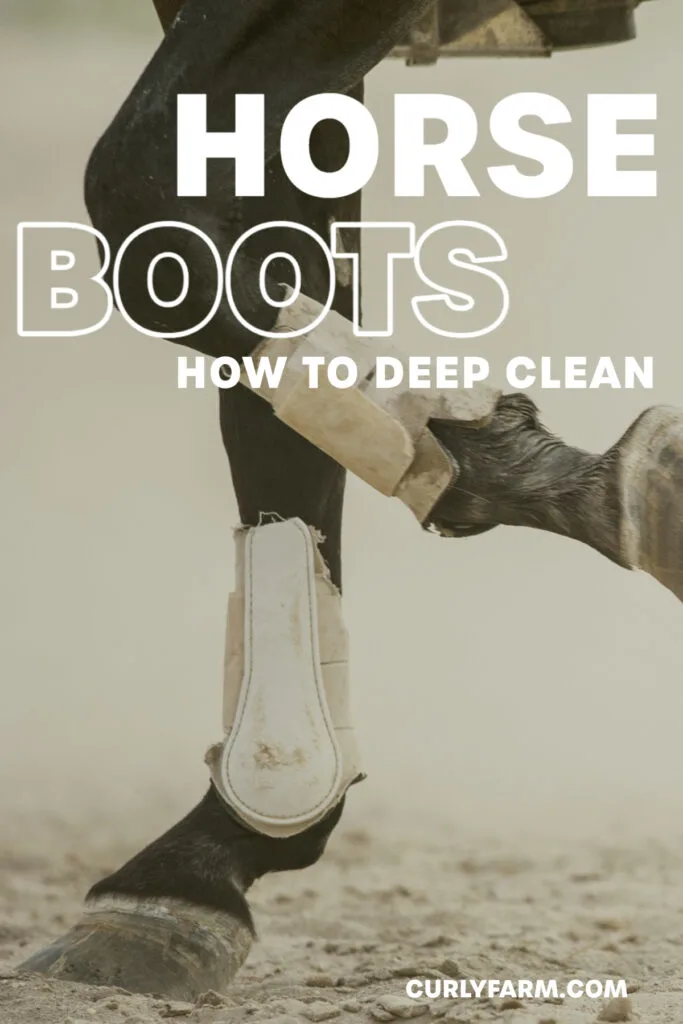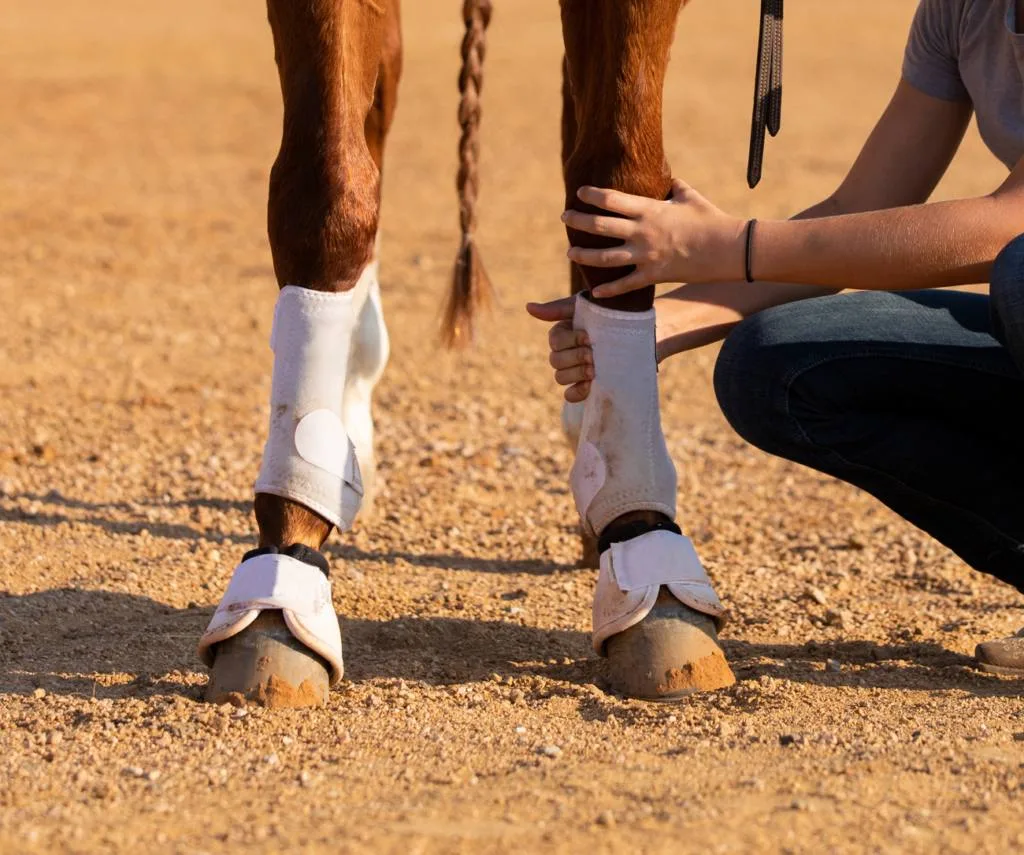You may think that a guide to how to clean horse boots might be as brief as just instructions to toss them in a washing machine, but keeping your horse boots looking their best actually takes a bit more care. With proper cleaning, horse boots last longer, provide better protection, and create a more professional turnout. In this article, we’ll discuss ways to clean horse boots to make them look (and work) like new.
My experience cleaning horse boots
Having kept horses for more than a decade, with up to 10 on our farm at a time, I’ve gathered a bit of experience with horse boots – even though our curly horses don’t often require the use of boots and wraps. As a tack store owner, tack repairer, and constant creative, I began experimenting with repairing tack instead of replacing it almost a decade ago.
With only a few tools for repair and for cleaning, I’ve been able to restore and use broken or heavily soiled boots countless times. While it’s popular to replace a broken item with a newer, brighter model, there’s something really satisfying in mending, repairing, cleaning, and restoring – plus, the environmental impact of repairing rather than replacing items like horse boots adds up over time to, resulting in waste in landfills.

What type of boots does this guide work for?
This guide to how to clean horse boots can be adapted for tendon boots, open-front boots, shipping boots, fly boots, and other styles of horse boots. While not specific to wraps like polo wraps, standing wraps, and pillow wraps, many of the tips offered in this tutorial on how to clean horse boots can be applied to horse leg wraps.
How to clean horse boots
How to clean horse boots
Time Required including Drying 24 hours
Step One. Brush off excess dirt and hair.
Hold the boot in your non-dominant hand and use a stiff-bristled horse grooming brush or dry scrub brush in your dominant hand. Aggressively brush the surface of the horse boot inside and out with the bristles of the brush. The bristles of the brush will lift and brush away much of the surface dirt and hair on the dirty horse boots, which makes washing the boots easier.
Step Two: Use tape to lift embedded hair
If your horse boot has hair embedded in the fabric, fleece, or sheepskin lining of the boot, wrap your hand with an inside-out loop of packing tape and pat it against the surface to catch and remove hairs. You can use a lint roller for this step, but packing tape tends to have more adhesiveness which is great for pulling hair from horse boot liner fabrics from luxurious sheepskin to the more common neoprene.
Step Three: Inspect before Cleaning
Now that the surface dirt and debris have been removed from your horse boots, it’s time to inspect your boots before you continue with the cleaning process. Check buckles and straps for fraying or signs of damage. Stop cleaning and throw away boots with significant damage to the straps or body of the horse boot. Horse boots that break loose – or come off partially- during use can be extremely dangerous.
Step Four: Clean Horse Boot Closures
Many horse boots attach with VELCRO® Brand fasteners or an off-brand version of similar hook and loop tape. but over time both hook and loop and VELCRO® Brand fasteners pick up tiny particles of dirt, hay, manure, and other fibers. As the tiny hooks and loops become matted with debris, the fastener become less “sticky.” Cleaning VELCRO® Brand fasteners can help restore hook and loop straps to their full power.
The fastest way to clean the hook and loop fasteners on the straps of horse boots is by using a cleaning brush specially designed to clean the crud out from between the tiny filaments that make up a hook and loop pad. If you don’t have a special cleaning brush, you can use a safety pin and tape:
Open a safety pin and slide the sharp edge along the fastener pad in between the hook filaments. The metal will dislodge particles that you can then lift away and dispose of using the tape to capture. In just a few minutes, your boots fasteners can be restored to like-new adhesion so when you are finished cleaning your boots, they’ll work just like new!
Step Five. (Sheepskin or fleece lined boots only) Brush Liner
If your horse boots are fleece, sheepskin, or shearling fleece lined, the next step is to comb and fluff the matted fleece. With the right tools and technique (described in our post on how to restore matted fleece saddle pads) you can clean your sheepskin-lined horse boots and restore gross matted sheepskin to fluffy and fresh in minutes.
Here’s how to clean horse boots’ sheepskin liners: you’ll need a slicker brush. Typically used for dogs and cats, a slicker brush has tiny bent tines on the brush pad which can be used to separate matted fleece fibers and pull out debris embedded in the plush lining. Comb the liner of your horse boots until the fleece is fluffy and fresh with no matted areas. Brush in multiple directions for best results.
Step Six. Wash Horse Boots (Skip if Leather)
Now that you’ve removed excess dirt, inspected straps, cleaned fasteners, and repaired any fraying synthetic fiber, it’s time to wash your boots. For best results, wash your dirty horse boots in a washing machine. Secure the horse boots by sticking any hook and loop pads together and/or buckling straps and place the horse boots inside of a laundry bag designed for washing delicate laundry (alternately, you can wash horse boots by placing them in a pillowcase that is then tied at the top.)
This prevents excessive wear and tear to either the boots or your washing machine. Wash on gentle with a mild detergent and be sure to include an extra rinse cycle to remove any remaining detergent which could irritate skin or attract dirt. After washing, hang your boots to dry in a sunny or breezy location until completely dry.
Step Seven. Repair Frayed Straps
Part of maintaining synthetic material while cleaning horse boots is managing any frayed portions of the boot before the damage becomes so bad that the boot must be thrown away. As you inspect your horse boots look for frayed nylon or polyester fibers.
These fibers can be singed away to create a cleaner, safer, longer-lasting edge on the strap of the boot. If you notice fraying, you can use a lighter held near (but not in contact with) the fibers to singe them away. Work outdoors within arms reach of a fire extinguisher or water source for safety.
Step Eight. Finishing Touches.
Once you’ve finished cleaning horse boots and the boots are dry after washing the fabric or cleaning the leather, do a final inspection before returning your horse boot to active use. An essential step in how to clean horse boots is to finish by inspecting to make sure that the washing machine didn’t damage the boot, and re-fluffing the liner if needed. If your boots are leather with metal buckles, you can use a bit of metal polish to brighten up the buckles to make them shine just like new.
Estimated Cost: 3 USD
Supply:
- Lingerie Bag or Pillowcase
- Hypoallergenic Detergent
- Safety Pin
Cleaning Leather Horse Boots
If you are trying to clean leather horse boots like tendon boots or open front jumping boots, you’ll need to give the leather-appropriate care. That means washing with a gentle leather-safe detergent and a moist sponge.
Use a soft brush – such as an old toothbrush – to be sure to wash away dirt in between straps and in the grooves of stitched seams of the leather. Allow the boots to dry completely and then give them a very light coating of oil (Too much oil on the leather will contribute to rotting and can leave the surface gummy – causing it to attract dirt and get even dirtier than when you started cleaning your boots.)

Keeping horse boots clean
The following section may contain affiliate links. As an Amazon Associate, we earn from qualifying purchases.
Now that you’ve thoroughly cleaned and restored your horse boots, let’s talk about how to keep them clean so you can stretch the time between cleanings and help them last even longer with less maintenance. One of my favorite tips for keeping horse boots bright and new looking is an easy spray-on application of Scotchgard – it really does work to prevent stains and repel dirt!
This product is typically used on outerwear to help prevent and risk repel stains, but it’s one of my best tools in my arsenal of horse show prep and equipment maintenance. Simply spray the protective spray on all services of your horse boot while standing outside in a well-ventilated area, and let dry completely before use. (The brand and type of stain protection you purchase may have different instructions vary, so follow those instructions carefully for best results protecting your horse boots)
Storing Horse Boots in your Tack Room
If your horse boots didn’t come with a storage bag, purchasing one is a great way to make sure that your horse boots stay clean when they are not in use. The last thing you need is to pull your boots out of storage and find them already soiled and dirty from having been stored near other equipment. A simple lightweight cotton or polyester bag with a drawstring is a great way to organize horse boots, keep colors together, and prevent them from getting dirty when not in use. I like these cotton drawstring bags– they are a perfect size, wash easily, and are environmentally friendly.
Special care should be taken when storing boots for the winter- especially if you don’t plant to use them regularly through the winter. Pests like mice are a reality in many barns and tack rooms, so taking proactive steps to protect your tack from these burrowing creatures can save the expense of having to buy new equipment next spring. For best results, store your horse boots in the off-season in airtight, sealed containers such as Rubbermaid totes
To prolong the life of your horse boots and any other equipment stored in winter storage, add a few packets of silica to absorb any trapped moisture in the box, and a sachet of cedar wood shavings which can prevent damage to sheepskin and other natural fibers from wool moths. For even greater protection for non-leather and non-sheepskin horse boots, consider using space-saving vacuum-sealed bags. These bags, which can be sealed with a shop vac or horse vacuum common in many barns, can help not only to store your clean horse boots in a smaller amount of space but also completely seal them off from insect and rodent damage while they are in storage.


